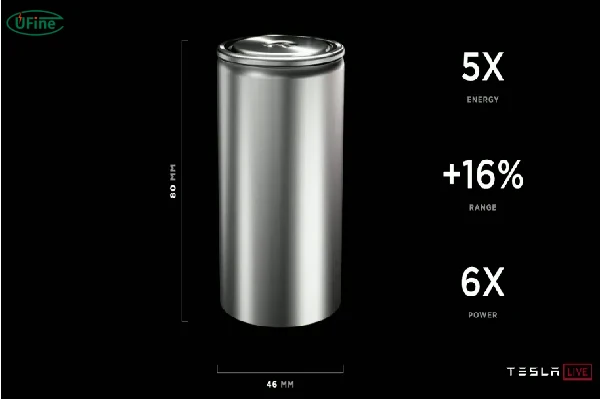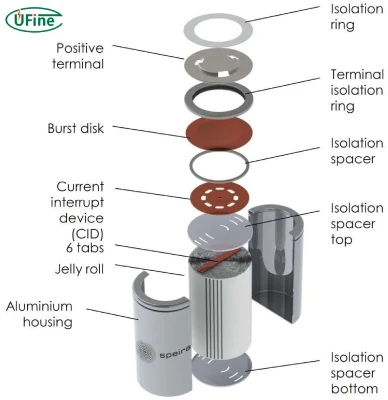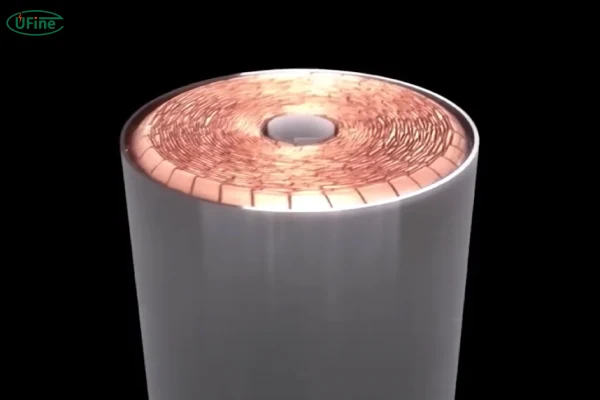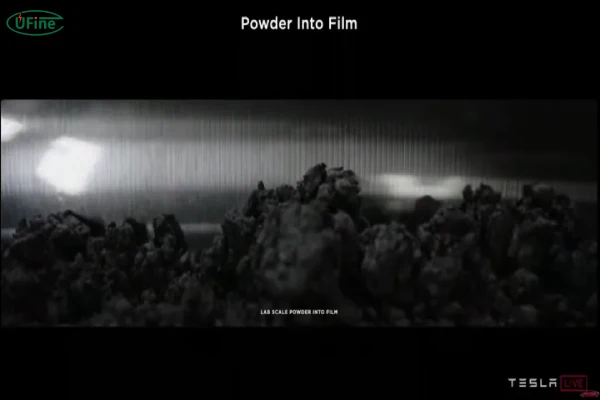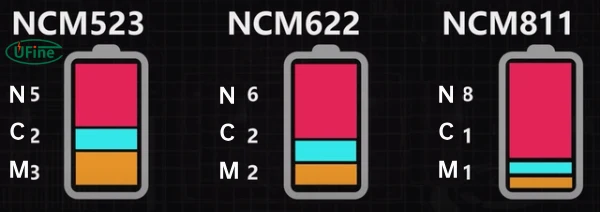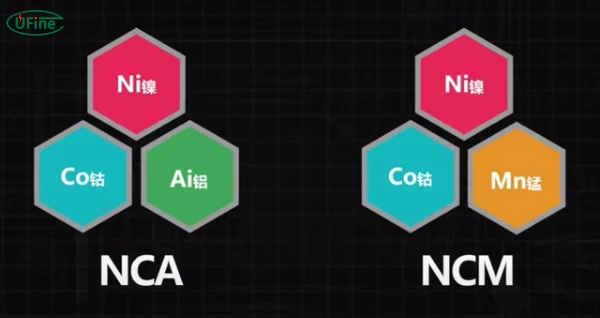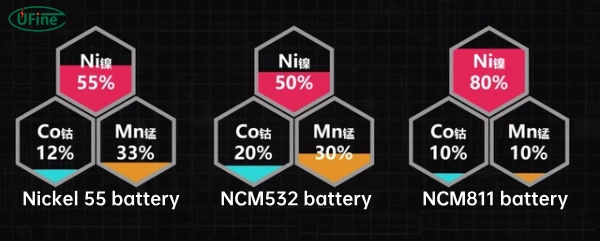Part 1. Overview of 4680 battery
1. What is 4680 battery?
4680 battery is a new generation cylindrical battery with a diameter of 46mm and a height of 80mm launched by Tesla.
For batteries, when energy density increases, power density will decrease. The diameter of 46mm is the best choice for cylindrical batteries with both high energy density and high power density.
2. Core innovation of 4680 battery
Large battery cell + tabless + dry battery technology
3. Performance breakthrough of 4680 battery
4680 battery greatly improves battery power (6 times that of 2170 battery), reduces battery cost (14% of 2170 battery), optimizes heat dissipation performance, production efficiency, and charging speed, and energy density and cycle performance have room for further improvement.
Part 2. Structural change of 4680 battery
4680 battery greatly improves battery power, optimizes heat dissipation performance, production efficiency, and charging speed through changes in tab structure.
1. Tabless structure
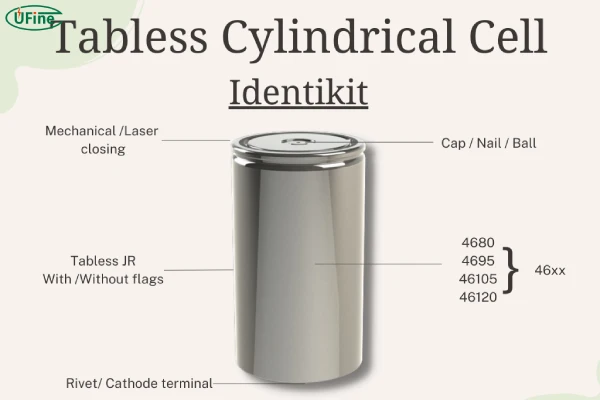
What is tab?
A metal conductor that leads the positive and negative electrodes from the battery cell. It is the contact point when the battery is charged and discharged.
During battery operation, electrons flow from the positive tab to the negative tab, and the flow path is proportional to the battery internal resistance, and the flow width is inversely proportional to the battery internal resistance. The internal power loss of the battery is proportional to the square of the internal resistance. Therefore, the larger the tab contact area, the shorter the tab spacing, and the higher the battery output power.
Traditional batteries have only two tabs, connecting the positive and negative electrodes respectively. The 4680 battery implements tabless (cutting the tab directly from the positive/negative electrode). This greatly increases the current path and shortens the tab spacing, thereby greatly increasing the battery power.
2. Advantages of tabless battery
- Increased output power: The battery current path becomes wider, and the internal resistance is greatly reduced, and the internal loss is reduced accordingly, thereby greatly increasing the battery power (6 times that of 2170 batteries).
- Improved safety: Unlike sheet batteries, cylindrical batteries have mostly axial heat dissipation, and heat is dissipated from the tabs. Traditional cylindrical batteries such as 2170 only have two tabs, and the heat transfer channel is narrow, so the heat dissipation effect is not good. The tab area of 4680 battery is greatly increased, and the heat transfer channel is wide, which greatly improves the heat dissipation effect (only 20% of traditional cylindrical batteries). This enhances the thermal stability of the battery.
- Greatly improved fast charging performance: Due to the tabless structure, electrons are easier to move inside the battery. In this way, the current rate is increased, so the charging and discharging speed is faster.
- Improve production efficiency: Eliminate the process and time of adding tabs to the production line, save equipment space, and reduce the possibility of manufacturing defects.
3. Difficulties in tabless production
A. Challenges in collecting tabs in tabless production
In a general sense, it is a process of folding tabs together. Currently, there are three types: kneaded tabs, cut tabs, and multiple tabs:
- The tab shape of kneaded tabs is uncontrolled, which is prone to short circuits. The two sections are closed during manufacturing, which greatly hinders the penetration of electrolyte;
- Cut tabs (Tesla) are cut into pieces and rolled up, which is better than irregular extrusion and occupies less space. However, the surface undulation is large, the two sections are still closed during manufacturing, and the injection cannot be produced continuously;
- Multiple tabs are difficult to fold neatly, and the tab position error is easily magnified in the outer circle.
B. The connection between tabless and collector plates or shells requires high laser welding technology.
From spot welding (traditional two tabs) to surface welding (tabless of 4680 batteries), the welding process and welding amount have increased. The laser intensity and focal length are not easy to control. This makes it easy to weld through or burn into the battery cell, which leads to the current low battery yield (80%).
4. Opportunities for tabless
From the previous pulse laser spot welding of 2170 cells to the current 4680 cell line or laser dot matrix, the laser welding process has been improved. This may change from the original pulse laser to a continuous laser, and the overall cost will increase.
Part 3. Large battery cell
1. Performance
The 4680 battery has an improvement in diameter and height compared to the previous 2170 battery. The diameter has changed from 21mm to 46mm, and the height has changed from 70mm to 80mm. The thickness of the battery cell has increased, the curvature has decreased, and the hollow part has become larger.
2. Advantages of larger size
- Reduce battery costs: Reduce the proportion of the shell in unit battery capacity, and the number of structural parts and weldings is also significantly reduced (the cost is 14% lower than that of 2170 batteries).
- Improve capacity density: As the size of the battery increases, the number of cells in the battery pack decreases, the proportion of metal casing decreases, the proportion of positive and negative electrodes and other materials increases, and the energy density increases.
- BMS is more worry-free: the number of batteries in the battery pack is reduced, making battery monitoring and status analysis simpler.
- Increased structural strength, perfectly combined with CTC technology: 4680 is larger in size and has higher structural strength. As a structural battery, it becomes part of the vehicle structure. This not only provides energy but also serves as a structural support, saving space and reducing weight (10%), thus increasing range (14%).
3. Disadvantages of larger size
Increased heat generation: The larger the battery size, the more heat it generates and the harder it is to dissipate heat.
Therefore, heat control is more difficult, and the power of battery explosion is greater. This was also the biggest bottleneck for previous battery manufacturers who wanted to increase battery size. Tesla has made a breakthrough in thermal stability performance through tables technology.
4. Actual performance
As the battery size increases, the number of cells in the battery pack decreases, the proportion of metal casings decreases, the proportion of positive and negative electrodes and other materials increases, and the energy density increases. Compared with the 2170 battery, the energy of the 4680 battery has been increased by 5 times. The current increase in cruising range (16%) mainly comes from CTC technology (14%). With the continuous upgrading of the material system, there is room for further improvement in battery energy density.
Part 4. Dry battery technology
Dry electrode technology can be used on both positive and negative electrodes.
1. Traditional wet process
This process requires the material to be placed in a solution, dried and pressed into a film.
Solvents with adhesive materials are used, with NMP (N-methylpyrrolidone) being one of the common solvents. After mixing the solvent with the binder and the negative electrode or positive electrode powder, the slurry is applied to the electrode current collector and dried. The solvents are toxic and need to be recovered, purified and reused. Huge, expensive and complex electrode coating machines are required in the middle.
2. Dry battery technology
The dry electrode process completely skips the step of adding solution, can omit complicated coating, drying and other processes, and greatly simplifies the production process.
The active positive and negative electrode particles are mixed with polytetrafluoroethylene (PTFE) to make them fiberized. Directly roll the powder into a thin film and press it onto aluminum foil or copper foil to prepare positive and negative electrode sheets.
3. Advantages of dry batteries
- Simple process and cost saving: no solvent is used, eliminating the need for expensive coating machines.
- Improve production efficiency: Dry electrode technology increases production speed to seven times that of the previous one.
- Increase battery energy density: In the presence of solvent, lithium and carbon mixed with lithium metal cannot blend well with each other, causing the problem of first cycle capacity loss. Dry battery technology will greatly improve this problem, thereby increasing battery energy. density. At the same time, the thickness of the positive electrode material is increased from 55 μm to 60 μm to increase the active electrode material ratio. The energy density is increased by 5% while ensuring the power density.
4. Dry battery process challenges
The current technology is immature, the battery needs to be thick, and the cylinder needs to be rolled up, which is prone to cracking.
Part 5. Silicon negative electrode
1. Advantages
a. Higher theoretical energy density: The theoretical maximum battery capacity of graphite negative electrode is 372Wh/kg. The theoretical maximum battery capacity of silicon negative electrode can reach 4200Wh/kg.
b. Better safety: Silicon has a higher voltage platform than graphite. Now negative electrode graphite will produce lithium dendrites. This is because their voltage platform is close to the precipitation potential of lithium, and the dendrites pierce the diaphragm. The positive and negative electrodes will short-circuit, seriously threatening battery safety.
c. Lower cost: Silicon materials are widely available, with abundant reserves, low production costs, and environmentally friendly. The mass energy density of lithium-ion batteries using silicon negative electrode materials can be increased by more than 8%, and the volume energy density can be increased by more than 10%. At the same time, the cost of each kilowatt-hour battery can be reduced by at least 3%.
2. Disadvantages
a. Poor cycle performance: volume expansion after lithium insertion, graphite has no obvious volume expansion after lithium ion insertion. However, silicon expands more than four times after lithium ion insertion. After several expansions and contractions, the battery is scrapped.
b. Poor conductivity: The low conductivity of silicon limits the full utilization of its capacity and the rate performance of silicon electrode materials. The volume change makes the active material poorly contacted with the conductive agent binder, and the conductivity decreases. The SEI film on the silicon surface is thick and uneven, affecting the conductivity and the overall specific energy of the battery.
3. Innovative design of 4680 battery
Tesla redesigned the raw materials, adopted highly elastic materials, and by adding elastic ion polymer coatings, it can stabilize the silicon surface structure and reduce costs by 5%.
4. Silicon-carbon anode is the development direction of silicon anode
a. Battery companies actively apply silicon-carbon anode:
Silicon-carbon anode is currently mainly used in cylindrical batteries. Chinese battery manufacturers, such as CATL, Lishen Battery, Guoxuan High-tech and Pride, have a clear development direction for high-capacity battery solutions for power battery manufacturers.
b. Acceleration of R&D and production of silicon-carbon negative electrodes
The global silicon-carbon industrialization is relatively advanced, and Chinese manufacturers are actively catching up. At present, Chinese negative electrode manufacturers have expanded their investment in silicon-carbon negative electrodes. BYD, Shanshan, Guoxuan High-tech, and Zhengtuo Energy can achieve mass production. Among them, BYD’s silicon-carbon negative electrode supplies Panasonic power batteries and enters Tesla’s industrial chain. Some battery companies such as CATL, BYD, Guoxuan High-tech, BAK and Tianjin Lishen are actively deploying silicon-carbon.
Silicon-carbon batteries are an inevitable trend in the development of high energy density. With the overcoming of technical bottlenecks and the improvement of end-customer acceptance, silicon-carbon will reduce costs and achieve large-scale mass production.
Part 6. Positive electrode
Different electrodes are used in different batteries:
- The iron-lithium version of 4680 will be used in low-range models and energy storage batteries, focusing on more cycles;
- The nickel-manganese-lithium 4680 battery is used in medium-range models and household batteries;
- The high-nickel 4680 battery is used in cybertruck and Semi;
Tesla’s positive electrode materials focus on high-nickel cobalt-free direction. However, no innovations outside the mainstream route are proposed: using the NCA single crystal route, increasing the energy density by increasing the voltage, and the thermal stability of the material is comparable to lithium iron phosphate.
1. NCA
The ternary positive electrode material route is generally divided into two:
1) NCA (nickel-cobalt-aluminum) adopted by Tesla;
2) NCM (nickel-cobalt-manganese), such as NCM523, NCM622, and NCM811 used by CATL.
The role of elements in positive electrode materials is:
- Nickel: Increase battery energy density and reduce battery cost. It is the key to improving battery life.
- Cobalt: As a positive electrode support structure, it is strong, but expensive and pollutes the environment.
- Manganese and aluminum: Improve the thermal conductivity of the material, which is the key to thermal stability and safety.
- Iron: An alternative material for nickel, with low energy density, but cheap price and higher charge and discharge times.
Compared with NCM, NCA has a higher energy density and higher process requirements, but poorer safety. Tesla increases the nickel content and reduces the cobalt content, thereby increasing energy density and reducing costs.
2. Single crystalization
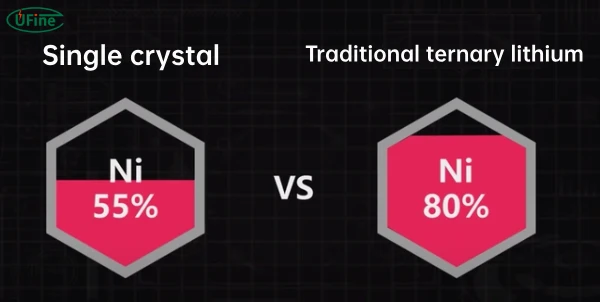
Unlike increasing the nickel element to increase energy density, single crystalization increases energy density by increasing the voltage of the positive electrode material. Compared with traditional polycrystalline materials, single crystal materials are more suitable for high voltage, have no grain boundaries, and can improve the thermal stability and cycle performance of ternary batteries.
The high-voltage single crystal material nickel 55 battery represented by the 5 series only uses the same nickel content as NCM523 to achieve the energy density of NCM811. And it has more outstanding material thermal stability and lower cost than NCM811.
3. Trend of 4680 battery positive electrode
4680 battery actually has three different positive electrode materials: iron-lithium, nickel-manganese-aluminum, and high nickel.
1) 4680 battery is currently mainly in the direction of high nickel
The 4680 high nickel version is Tesla’s current main direction, and will be used in the Cyber truck and Semi with high battery life in the future. At the same time, the long-range and high-performance versions of Model 3 and Model Y can also be used.
2) The nickel-manganese version of 4680 battery will follow the high nickel version
After the 4680 high nickel version technology matures, the 4680 nickel-manganese version will be developed. It will be used in products such as the medium-range Model Y and household batteries.
3) 4680 battery may also use iron-lithium positive electrode in the future
4680 battery may also use iron-lithium positive electrode. Tesla battery press conference did not mention its cycle performance. Because the volume expansion of silicon-based anodes reduces the number of charge and discharge times, after the nickel-manganese version of the 4680 battery technology matures, the iron-lithium version of the 4680 battery is likely to be launched and used in low-priced models and energy storage batteries, focusing on high cycle performance.
The battery model gradually develops from the high-nickel version to the nickel-manganese version and finally to the iron-lithium version of the 4680 battery, which will drive the demand for related materials.
Part 7. Conclusion
The core innovative process of 4680 battery is: large battery cell + tabless + dry battery technology. This enhances battery power and safety, improves production efficiency and fast charging performance, reduces battery cost, and has room for further improvement in energy density and cycle performance.
In essence, after all, 4680 battery is a large-size container. Since it can be filled with ternary lithium, it can naturally be filled with lithium iron phosphate, and even further reduce costs. It can also be seen from the current trends of major battery manufacturers that many parties in the industry chain are actively developing 4680 batteries.
Related Tags:
More Articles

How to Choose the Best Floor Scrubber Battery for Commercial Cleaning?
Selecting the ideal floor scrubber battery ensures a long runtime, rapid charging, and minimal maintenance for efficient commercial cleaning operations.
Battery for Blower vs Battery for Leaf Vacuum: Which One Should You Choose?
Battery for blower vs leaf vacuum—learn the key differences in power, fit, and runtime to choose the right battery for your outdoor tool needs.
How to Choose the Right Battery for Blower?
Choosing the right blower battery? Consider voltage, capacity, chemistry & usage. This guide helps match the best battery for peak performance.
How to Choose the Best Insulated Battery Box for Lithium Batteries?
Choosing the Best Insulated Battery Box for Lithium Batteries? Discover key factors such as size, material, and safety for optimal protection and performance.
7 Critical Elements on a Lithium Battery Shipping Label
What must be on a lithium battery shipping label? Learn 7 key elements to ensure safety, legal compliance, and correct handling across all transport modes.
